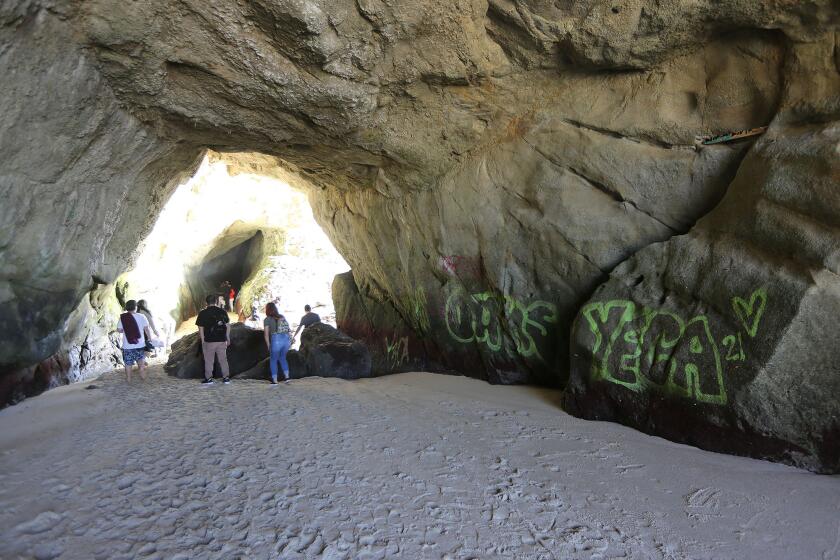Nonprofit creates Orange County’s first digital map of historic places
- Share via
Historic places in Orange County could be destroyed or replaced without support from the public. Yet many county residents are unaware of the history that surrounds them.
To educate the public on these places, Preserve Orange County, a historic preservation group, is releasing the county’s first interactive, digital map of historic places.
Preserve O.C. has been hoping to develop the map since it formed in 2017. The county’s historical commission created a paper map a few years ago.
“It’s something that we’ve wanted to do from the beginning, which is part of educating the public about what is architecturally and culturally significant in Orange County,” said Alan Hess, architect and chair of the nonprofit’s board. “Unfortunately, people just don’t think there’s anything historic here.”
The map will be online starting Friday. It was developed for the nonprofit over a two-year span by Juan Thomassie, who teaches visual communication at Ohio University.
The map currently includes 292 sites, though the nonprofit will continue to update the map with other historic areas in the county. Preserve O.C. is also asking for the public to recommend sites or buildings for addition to the map.
Of those 292 sites, Hess said 127 are on the National Register of Historic Places and 143 on California’s Register of Historical Resources. If a place is on the state register, it’s usually on the national register, he said.
Many of the places are not officially designated, which puts them more at risk of being destroyed or modified.
“We started with official, recognized landmarks in the county, but then we realized that wasn’t enough,” Hess said. “So we have added, by talking to different historians, a number of buildings which are undesignated. Unfortunately, there are a lot of important buildings here that are not designated officially, and that threatens them.
“If somebody wants to save a building but they can’t say that the building is recognized on such and such a list, that can often be the death warrant for an otherwise great building.”
Hess and his colleagues at Preserve O.C. have been fighting to keep historic places intact. But it can be much easier to convince a city to preserve a building with support from the public, he said.
He hopes that the map will spark interest from the public and will lead to more engagement with the county’s historic resources.
The Laguna Beach City Council approved a $2-million neighborhood and environmental protection plan aimed at mitigating the impact of visitors on the community at its meeting on March 9.
One of the most revered historic places that will be on the map that may not be known to the general populace is the Lovell house in Newport Beach.
The building was constructed in 1926 and was designed by famed architect Rudolph Schindler. Hess said it’s recognized as one of the most important early examples of modern architecture.
“Schindler, of course, is in the architectural world a very well-known name, but people don’t realize that this masterpiece of his is in Orange County,” Hess said. “Most of his work is up in Los Angeles. So we’re very proud of that.”
The list also includes the “Eichler neighborhoods” in Orange, which are part of the style that came to be known as “California Modern.”
“Joseph Eichler was a builder who developed mass-produced trap housing, but in a modern style from the early 1960s, and those are on the National Register as well,” Hess said. “So it’s a whole neighborhood with these really beautiful modern houses.”
Hess hopes that the map will help spread his passion for historic preservation.
“People often just think of historic preservation as saving an old Victorian house that’s quaint and beautiful, and it may have a house museum in it,” Hess said. “But preservation is about so much more.”
Hess said there are economic impacts to preserving historic buildings.
Old Towne Orange, with its Craftsman-designed and Victorian-era buildings, has remained a vibrant destination for locals and tourists.
“Because those buildings were saved, downtown Orange has an economic life,” Hess said. “... In contrast, Anaheim virtually wiped out all of its older buildings in the downtown area, and it has been struggling.”
There are also lessons stored in these historic places. Like the former Lydia D. Killefer School in Orange, the first school to voluntarily desegregate in Orange County in 1944. The building, which is listed on the National Register of Historic Places, is being renovated by Chapman University.
Hess said that places can still be modified or demolished even if they’re on a historic register. He said the county has lost several buildings designed by Richard Neutra, one of the most famous architects of Southern California.
Hess said that sets a precedent.
“No building is safe,” Hess said. “Which is why we started Preserve Orange County. We have lost so much over the years.”
All the latest on Orange County from Orange County.
Get our free TimesOC newsletter.
You may occasionally receive promotional content from the Daily Pilot.





